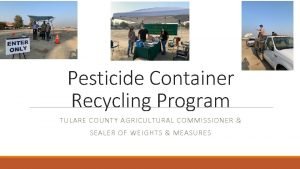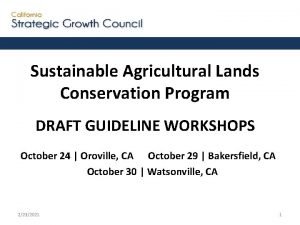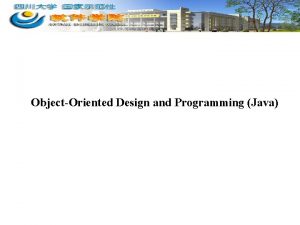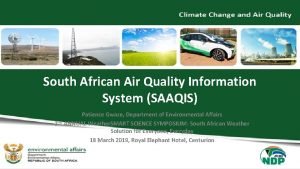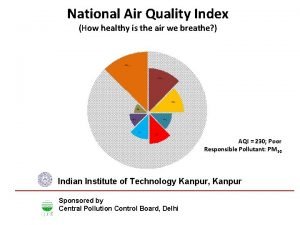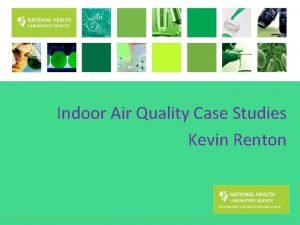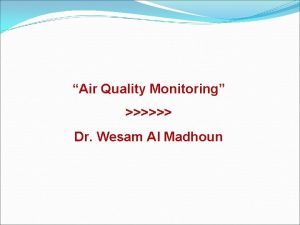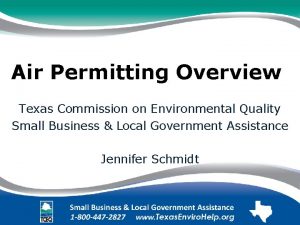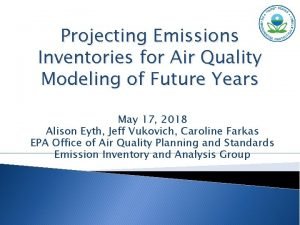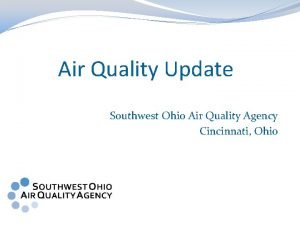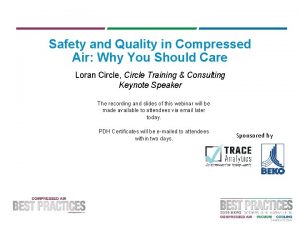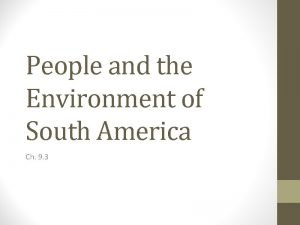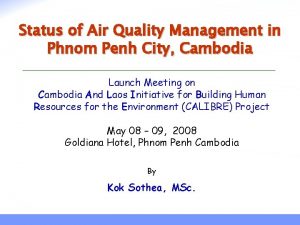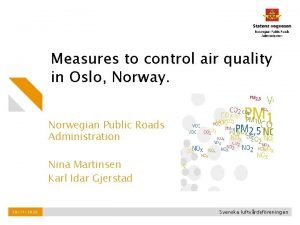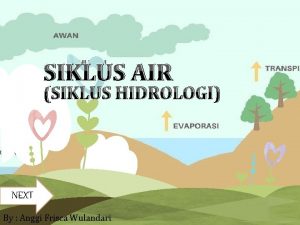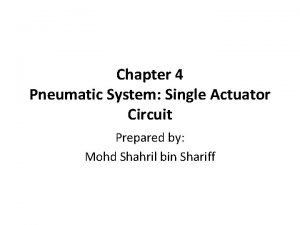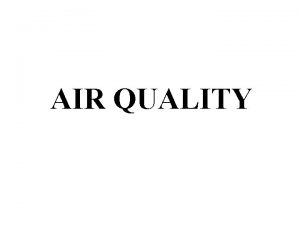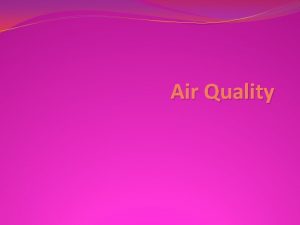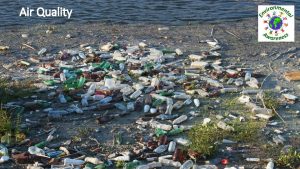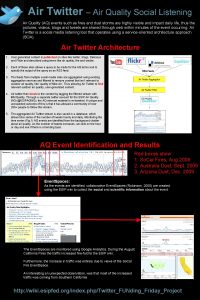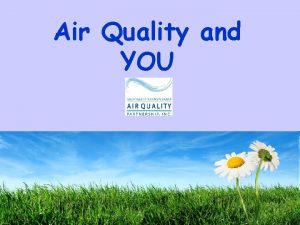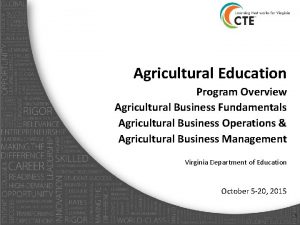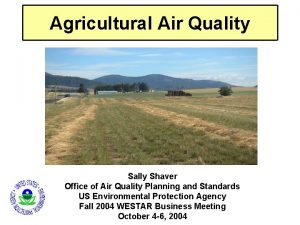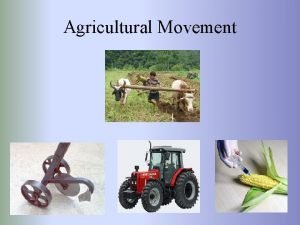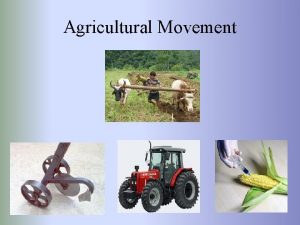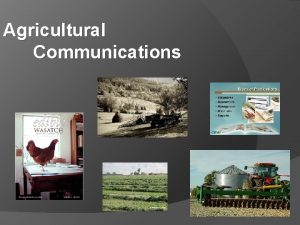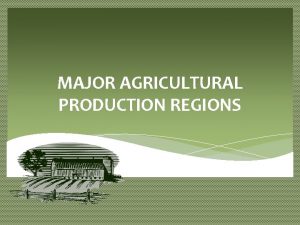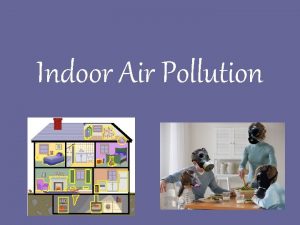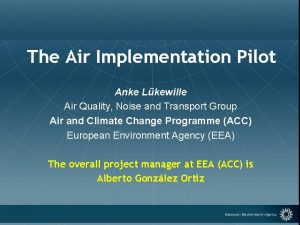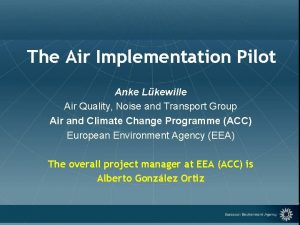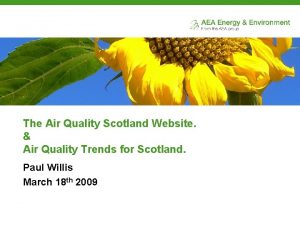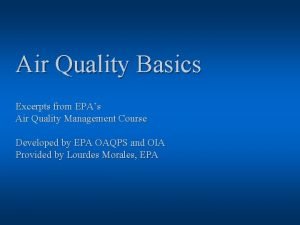Implementation of an Agricultural Air Quality Program Tulare
































- Slides: 32

Implementation of an Agricultural Air Quality Program Tulare Ag Expo February 11, 2004 David L. Crow Executive Director/Air Pollution Control Officer San Joaquin Valley APCD www. valleyair. org

Background • Long-standing permit exemption for Agricultural Sources under the State law • Federal law requires permits for major agricultural sources (Title I and Title V) • Federal sanctions (entire state) set for November 2003 unless ag exemption removed • SB 700 (Florez) -- Signed into Law in 9/2003

SB 700 Summary • Removes permit exemption for Agricultural sources (major and minor sources) • Requires Particulate Matter (PM) controls (including PM precursors) • Additional pollution controls and permits for Confined Animal Facilities (CAFs) • Offers off-ramps from pollution control and permitting • Treat agricultural facilities similar to other air pollution sources

SB 700 Control Requirements • BACM and BARCT for sources where technology is transferable • Controls for tilling, discing, cultivation, and raising of animals • Controls for fugitive emissions • Include measures for PM precursors • Enforceable rules and regulations

Minimum Permitting Requirements • Major agricultural sources will be subject to Title V and NSR requirements • District MUST require permits for agricultural sources with emissions at or above ½ the major source thresholds unless certain findings are made at a public hearing • District CANNOT require permits for sources with emissions below ½ major source thresholds unless certain findings are made at a public hearing

Permitting Offramp • District may exempt a source if: • Replace I. C. engines with electrical or State/EPA certified, and • Mitigate emissions from all ag activities, and • Mitigate emissions from all ag equipment • May serve as an incentive that could lead to air quality benefit

More Requirements for CAFs • 7/1/05 - CARB to define “Large” CAFs • 7/1/06 – District to adopt permitting and mitigation rules for “Large CAFs” • Degree of control = BARCT • Regulations must be submitted to EPA for inclusion in the SIP

More Requirements for CAFs (cont. ) • 1/1/07 - “CAF permit” applications due from “large” CAFs • District issue permits within 6 months (30 -day public notice) Sources to implement mitigation within 1 year • NOT a substitute for other permitting requirements

Permitting Timeline • Ag. exemption goes away 1/1/2004 • Existing sources: – Local permit applications due by 7/1/04 – Title V permit applications due 1/1/05 – Grandfathered (no BACT/ERCs) – BARCT/BACM later • New sources (e. g. , new dairies): – Effective 1/1/04 must obtain construction permits subject to BACT, ERCs, and public review

BACT Process • Find the most effective control that is: – Technologically feasible – Cost effective/Achieved in practice • Work with industry groups, individual dairies, equipment vendors • Public workshops • Evolve with time and science

Areas of Possible Dairy Controls and/or Practices • • • Milking Center Cow Housing/Feeding Manure Storage Piles Land Application of Waste Material Lagoons

Number of affected sources • Total number of facilities in the Valley: – Farms (~28, 000) – CAFs (~5, 500) • Facilities subject to BARCT/BACM: – Farms (~8, 000) – CAFs (~1, 100) • Facilities subject to permits – Farms (~4, 000) – CAFs (~350) – Fewer sources may be affected after closer examination

Rule 4550 Conservation Management Plans • Conservation Management Plans for Ag Sources • Implement Controls for On-field Activities • Similar to Permitting – but it’s Not Permitting • Sources Select from Control Options

CMP Program Concept • Mandatory participation for farm sites 100 contiguous acres and larger • Select 1 measure from each of 5 categories – – – Land preparation/cultural activities Harvest Unpaved roads Unpaved parking and staging areas Other – wind erosion prevention, waste burning • Relatively simple plans submitted to NRCS/RCD for review and to District for approval

CMP Program • Practices proposed by growers to be provided in a handbook • Growers can propose new measures for Ag Tech Committee review & District approval • New and improved CMPs as technology develops over time • Best Available Control Measures (BACM) • Help achieve annual 5% reduction in PM emissions

CMP Examples • Practices that reduce or eliminate the need to disturb the soil or manure • Practices that protect the soil from wind erosion • Equipment modifications to physically produce less PM 10 • Applying water or dust suppressants to reduce emissions entrained by moving vehicles and equipment • Reducing speed or access on unpaved roads and parking areas • Alternative practices to waste burning

CMP Timeline • • • Rule development now underway Final workshops in March 2004 Rule adoption May 2004 Outreach/education ongoing CMP Program implementation begins July 2004 • CMP Plans due no later than December 31, 2004 • Fees to cover plan program costs with 50% discount for NRCS verification

Ag Research Priorities • Dairy and other CAFO VOC emission factors – eventually need process based factors • CAFO ammonia and PM 10 emission factors • On field management practice PM 10 emission differentials • Equipment modifications to reduce PM 10 emissions

Ag Program Implementation • Extensive outreach – Coordination with Industry Groups • Small Business Assistance • User-friendly application forms • Web-based tools/aides • Development of good science and staff expertise • Coordination/Utilization with other agencies (e. g. , NRCS, County agencies) • Support legislation aiding effective implementation (e. g. , Eliminate utility stand-by charges) • Statewide coordination

Some Important Dates • 1/1/2004 – SB 700 Effective, No Ag Exemption , Title I&V • 1/15/2004 – Governing Board Approves Staffing • 5/20/2004 – District CMP Rule to Governing Board • 7/1/2004 – District Permit Applications Due • 1/1/2005 – Title V Application Deadline • 1/1/2005 – CMP Applications Due • 7/1/2005 – BARCT Rule for Ag IC Engines Due • 7/1/2006 – District to Adopt Large CAF Permit Rule • 1/1/2007 – Title V Permits Issued

Other Recent Air Legislation • SB 704 Biomass Funding- passed • SB 705 SJV Ag Burn Prohibition - passed - Phases out ag burning between 2005 and 2010 - District required to identify feasible alternatives to burning - Exceptions for diseased crops

SB 704 - Agricultural Biomass to Energy Program • Enacted September 22, 2003 • Uses $6 million from Revenue Trust Fund • $10/ton incentive for qualified agricultural biomass • Paid to biomass facilities meeting certain criteria • CEC will manage funds • CEC holding hearing to adopt program guidelines February 18, 2004 • All funds to be expended by June 30, 2004

SB 705 Changes to State Law • Added Sections 41855. 5 and 41855. 6 to the California Health & Safety Code • Prohibits the issuance of an agricultural burn permit within the San Joaquin Valley Air Basin for certain agricultural wastes, commencing on specified dates for each crop type • Prohibition does not apply to prescribed burning or hazard reduction burning conducted in the foothills and mountain areas of the District

June 1, 2005 – Phase Out • Field Crops: Alfalfa, asparagus, barley stubble, beans, corn, cotton, flower straw, hay, oat stubble, pea vines, peanuts, rice stubble, safflower, wheat stubble, and any other field crop • Prunings: Apples, apricots, avocados, bush berries, cherries, Christmas trees, citrus, dates, eucalyptus, figs, kiwis, nectarines, nursery prunings, olives, peaches, persimmons, pistachios, plums, pluots, pomegranates, prunes, quince, rose prunings, trees and branches associated with pasture or corral maintenance, and any non-surface harvested prunings • Weed Abatement: Berms, grass, fence rows, pasture, ponding or levee banks

June 1, 2007 – Phase out • Orchard Removals: Orchard removal matter, stumps, and untreated wooden stakes

June 1, 2010 – Phase Out • Other Materials: • Brooder paper, deceased goats, and diseased beehives • Surface Harvested Prunings: • Almond, walnuts, pecans, grapevines, and vineyard removal materials • Vineyard Materials: • Grape canes and raisin trays

Amendments to Rule 4103 (Ag Burning) By June 1, 2005, the District shall develop and adopt rules: • Establishing the best management practices for certain weeds and maintenance, as defined, and • Regulate the burning of diseased crops

Smoke Management • March 2001 - Title 17 California Code of Regulations • Districts given a mandate to develop better tools to manage smoke • Agricultural burning and Prescribed burning

Acreage Allocation • District determines atmospheric holding capacity in local geographic areas • Local meteorological data • Local air quality data • Local nuisance potential

How Will It Work? • Permitting process remains the same – same cost • Daily allocation for each geographic area will be established by District • No more burn or no burn days • Farmers call to request a burn - Accepted - Reduced acreage - Allocation full

Waiting List • Priority over new requests • You will receive an automated message the afternoon before you can burn • Choose to burn next day or delay up to 5 times • Call back to confirm that you will burn

Ways to request a burn • Talk to an operator in person • Use an automated phone system • Use the Internet
 Tulare air quality
Tulare air quality Tulare county recycling
Tulare county recycling Tnt swimming tulare
Tnt swimming tulare Air higroskopis air kapiler dan air gravitasi
Air higroskopis air kapiler dan air gravitasi Total quality management presentation
Total quality management presentation Sustainable agricultural lands conservation program
Sustainable agricultural lands conservation program Program to an interface, not an implementation
Program to an interface, not an implementation Implementing hrd programs
Implementing hrd programs Strategy vs adapter pattern
Strategy vs adapter pattern Quality assurance vs quality control
Quality assurance vs quality control Quality management pmp
Quality management pmp Quality metrics pmp
Quality metrics pmp Ana quality assurance model
Ana quality assurance model Quality improvement vs quality assurance
Quality improvement vs quality assurance Concepts of quality control
Concepts of quality control Which one is jurans three role model
Which one is jurans three role model Crosby quality is free
Crosby quality is free What is tqm
What is tqm South african air quality information system
South african air quality information system Air quality index calculation
Air quality index calculation Air quality renton
Air quality renton Ambient air quality standards
Ambient air quality standards St louis air quality
St louis air quality Tceq de minimis list
Tceq de minimis list Oaops
Oaops Southwest ohio air quality
Southwest ohio air quality Air quality
Air quality Sao paulo air quality
Sao paulo air quality Air quality phnom penh
Air quality phnom penh Oslo air quality
Oslo air quality Air di bumi selalu tersedia lantaran adanya... *
Air di bumi selalu tersedia lantaran adanya... * Contoh pelarut protonik
Contoh pelarut protonik Single acting cylinder pneumatic circuit
Single acting cylinder pneumatic circuit

